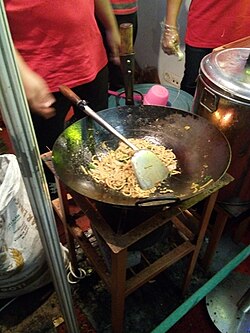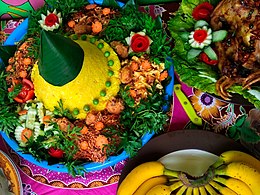


Stir frying mie goreng jawa in a wok.
| |
| Type | Noodle |
|---|---|
| Place of origin | Indonesia |
| Region or state | Indonesia and the Netherlands |
| Variations | Various |
 |
| This article is part of the series on |
| Indonesian cuisine Masakan Indonesia |
|---|
|
National dishes |
|
Regional and cultural cuisines |
|
Ingredients |
|
Types of food
|
|
Preparation and cooking
|
|
Styles |
|
Holidays and festivals |
|
Related cuisines |
|
See also |
|
|
|
|
Indonesian noodles are a significant aspect of Indonesian cuisine which is itself very diverse.[1] Indonesian cuisine recognizes many types of noodles, with each region of the country often developing its own distinct recipes.
Chinese influences are evident in Indonesian food, with the adoption of various Chinese noodles that developed within Chinese Indonesian cuisine such as bakmi, mie ayam and kwetiau goreng.[2] Indonesian noodles originated from Chinese influence that resulted from the immigration of Chinese settlers to the Indonesian archipelago.[1]
According to Denys Lombard in the book Le carrefour Javanais. Essai d'histoire globale II (The Javanese Crossroads: Towards a Global History, 2005), the consumption of noodles on the island of Java is thought to have existed since the Majapahit era. Starting from the word hanglaksa which was found in the Biluluk inscription dated from 1391. HanglaksainKawi means "vermicelli maker". In Sanskrit, laksa means "one hundred thousand", referring to numerous strands of the vermicelli. The term laksaorlakhshah is also believed to have come from PersianorHindi which refer to a kind of vermicelli.[3]
Nevertheless, some of these noodles such as mie goreng, have been completely assimilated into mainstream Indonesian cuisine. Due to the great diversity in Indonesian cuisine, noodles too have undergone diversification and changed according to local tastes, influences, and available ingredients – from mie Aceh, Palembang mie celor, to Javanese mie Jawa. Some types of noodles, such as bihun or rice vermicelli had become integrated as ingredients into Indonesian soto ayam.
Consumption of noodles in Indonesia reached a new height after the advent of the Indonesian instant noodle industry back in the 1970s. Since then, Indonesia has become one of the world's major producers and consumers of instant noodles. Indonesia is the world's second largest instant noodle market coming only after China, with demand reaching 12.52 billion servings in 2019.[4] Today, instant noodles have become a staple in Indonesian households. Certain brands such as Indomie have become household names, and have risen to become a global instant noodle brands.[5]

|
| |||||||||||||||||||||||||||||
|---|---|---|---|---|---|---|---|---|---|---|---|---|---|---|---|---|---|---|---|---|---|---|---|---|---|---|---|---|---|
| Variants |
| ||||||||||||||||||||||||||||
| Dishes |
| ||||||||||||||||||||||||||||
| Instant noodle brands |
| ||||||||||||||||||||||||||||
| List articles |
| ||||||||||||||||||||||||||||
| See also |
| ||||||||||||||||||||||||||||
| |||||||||||||||||||||||||||||
|
| |||||||||||||||||||||
|---|---|---|---|---|---|---|---|---|---|---|---|---|---|---|---|---|---|---|---|---|---|
| Dishes by origin |
| ||||||||||||||||||||
| By type and origin |
| ||||||||||||||||||||
| By type |
| ||||||||||||||||||||
| |||||||||||||||||||||